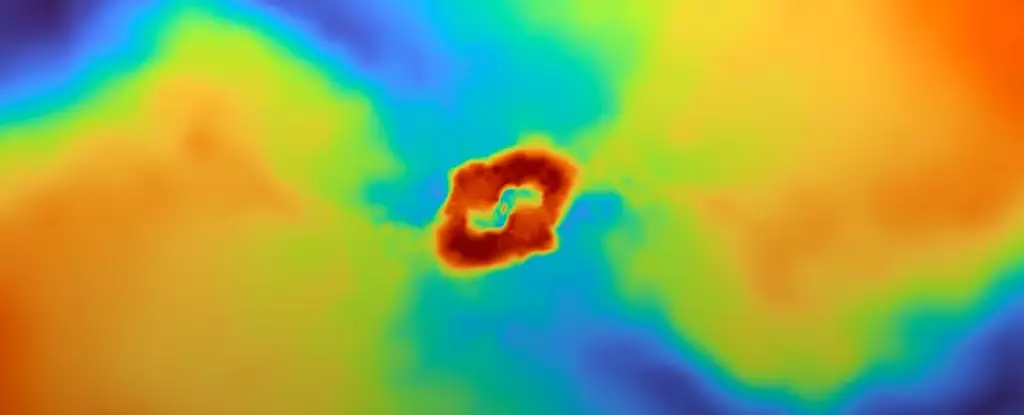

In a remarkable discovery, astronomers have potentially detected the afterglow of a massive collision between two giant planets. This finding offers a unique opportunity to witness the birth of a new planet and gain insights into the formation of planetary systems. The events unfolded in December 2021 when scientists noticed a flickering phenomenon in the light emitted by an otherwise ordinary sun-like star named ASASSN-21qj. Further analysis revealed that the star’s visible light had undergone periodic changes, almost disappearing at times before returning to its original brightness. This intriguing observation prompted researchers to delve deeper into the nature of the star and unravel the mysteries surrounding it.
The significance of ASASSN-21qj’s anomalies might have been overlooked if it weren’t for the keen eye of amateur astronomer Arttu Sainio. Sainio took to social media to highlight a previous increase in the emission of infrared light from the star’s location, which had occurred roughly two and a half years before the dimming of its visible light. Infrared light is typically emitted by high-temperature objects, and this led to the question of whether these two observations were connected and what was happening around ASASSN-21qj.
Based on their analysis, scientists propose that these observations could be explained by a cataclysmic collision between two planets. Giant impacts, as they are referred to, are believed to occur during the final stages of planet formation. They play a crucial role in determining the sizes, compositions, and thermal states of planets and can also influence the orbits of other celestial objects in the planetary system. In our own solar system, giant impacts explain phenomena such as the peculiar tilt of Uranus, the high density of Mercury, and the origin of Earth’s Moon. However, direct evidence of ongoing giant impacts in other galaxies has been scarce until now.
To account for the observed phenomena around ASASSN-21qj, the collision must have released more energy in its initial hours than the star itself emits. The impact would have caused the colliding bodies to heat up significantly, potentially melting or vaporizing them. The result would be a hot and glowing mass of material, several times larger than the original planets involved in the collision. Nasa’s WISE space telescope observed the infrared brightening of ASASSN-21qj, although it likely missed the initial flash of light produced by the impact. The expanded planetary body resulting from the collision would take millions of years to cool and shrink into a recognizable new planet.
The collision would have also ejected a substantial amount of debris into various orbits around the star. Some of this debris would have vaporized due to the shock of the impact, eventually condensing into clouds of tiny ice and rock crystals. Over time, these clumpy materials would have passed between ASASSN-21qj and Earth, partially blocking the star’s visible light and causing the irregular dimming observed by astronomers.
Studying the ASASSN-21qj star system offers valuable insights into the mechanisms of planet formation. Through the limited observations made thus far, scientists have made interesting discoveries. Firstly, the energy emitted by the post-impact body suggests that it was hundreds of times larger than Earth. This implies that the colliding planets were likely several times the mass of Earth, potentially comparable in size to Uranus and Neptune. Secondly, the estimated temperature of the post-impact body is around 700°C, indicating that it could not have been entirely composed of rock and metal. Instead, the presence of elements with low boiling temperatures, such as water, suggests that the colliding planets were rich in ice.
The time delay between the emission of infrared light and the observation of debris crossing the star indicates that the collision likely occurred at a significant distance from the star, similar to Earth’s distance from the Sun. This system, with ice giants positioned farther from the star, bears more resemblance to our own solar system than to the densely packed planetary systems commonly observed around other stars.
The most exciting prospect is that scientists can continue monitoring the evolution of the ASASSN-21qj star system for decades to come, allowing for extensive testing of their conclusions. Future observations, particularly with telescopes like NASA’s JWST, will enable researchers to determine the sizes and compositions of particles in the debris cloud, analyze the chemistry of the post-impact body’s upper layers, and track the cooling process of this hot mass of debris. Furthermore, it might be possible to witness the emergence of new moons in the system. These ongoing observations and studies will enhance our understanding of how giant impacts shape planetary systems, as the echoes of such impacts are currently only discernible within our own solar system.
The detection of the afterglow resulting from a colossal collision between two giant planets presents an extraordinary opportunity to witness the birth of a new world in real time. The observations surrounding the ASASSN-21qj star system allow scientists to explore the intricacies of planet formation and gain valuable insights into the processes shaping planetary systems. This discovery opens a new door to our understanding of the universe and fuels our curiosity about the wonders that lie beyond.
Rogue waves have long been a subject of fascination and terror in maritime lore. These…
As the world grapples with public health challenges, especially those posed by infectious diseases, the…
The Sombrero Galaxy, also known as Messier 104, embodies a breathtaking blend of spirals and…
In recent advances in quantum electronics, a groundbreaking discovery leveraging the concept of kink states…
In the intricate tapestry of nature, ice often exists in a delicate balance with liquid…
In an astonishing event that captured global attention, a rogue object from beyond our Solar…
This website uses cookies.